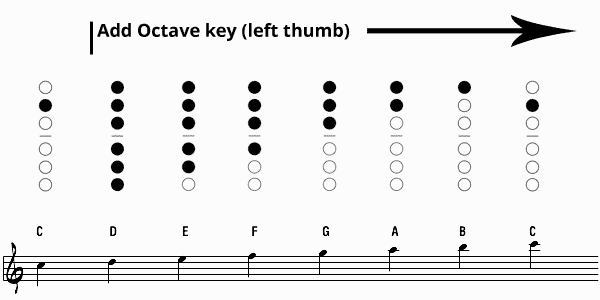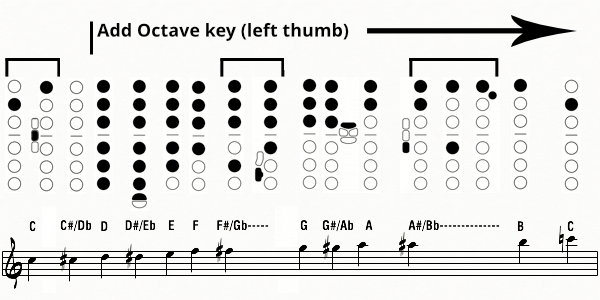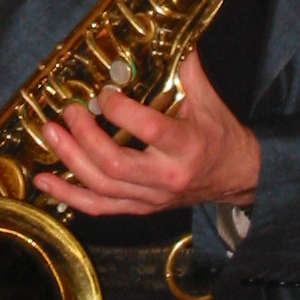Basic Fingering charts (no sharps or flats)
First we have a couple of very basic fingering charts which show you the saxophone fingerings for the lower and upper register in the key of C. These are ideal for absolute beginners who don’t want to be overwhelmed by the entire chart of all fingerings.
Of course, because the saxophone is a transposing instrument, the same fingering chart applies whether you play soprano, alto, baritone or tenor saxophone.
After that we have charts for the other notes. On this page I have only included the most common fingerings and a couple of alternative fingerings for the standard range.
The fingerings here are good for beginners to learn, but there are some more alternative fingerings. On this page we only show the standard range of the saxophone (up to F on older instruments and up to F# on many newer ones) but we also have a chart of fingerings for the extended (altissimo range)
Lower Register

Upper Register
(The octave key is the immediately above the left hand thumb rest)

First steps: Basic Fingering charts (with all sharps and flats)
Here we have all the notes of the lower and upper registers including the sharps and flats (AKA the chromatic scale)
In some cases alternative fingerings are shown. The first one in each case can be considered the “regular” fingering.
Lower Register

Upper Register

As you get more advanced: The bottom and Top Notes


Very helpful. I learned a lot from this page. I will be copying and pinning these charts to my walls. Good reference for beginners.
ese excelente fue excelente
I learned a lot from this page
Very useful!
Many thanks
Hello, I am a high school student who recently joined band. I struggled through marching band with trying to learn how to play the saxaphone, and I’m still struggling with learning. Band in high school is a lot harder than I thought it would be. I haven’t really been able to practice at my own pace. This website has helped me a lot by helping me practice on my own. Thank you
You have a mistake under Upper Register. The alternate fingering for third space C uses the left hand first finger with the right hand middle palm key, not the top one as you have indicated. An easy mistake to make.
Good catch! Odd that in many years nobody has noticed this! It should now be fixed.
More than useful. Thought I knew all the notes until I read the chart on upper and lower notes wow. Excellent. The upper and lower notes not even in my sax playing books
Very helpful to me as a beginner. My teacher has been doing great job but this chart actually threw more light. Do well by publishing subsequent steps. Thanks
Hi, I hurt my right hand little finger so it won’t bend very well. How the heck can I play e flat in the low register, do you have any alternatives?
By the way, GREAT SITE, packed with info!
Regarding the Eb fingering, some older Conns (and Bueschers) have an Eb trill key that may work for you. Otherwise this would be a good question to ask on the forum https://cafesaxophone.com
Where can I find a C melody sax fingering chart. Fir example, how do I play a “C”?
The fingering is the same for C melody as other saxophones. See Saxophone Transposition
Think you can add that C flat is the same as B? I couldn’t find it here and had too look somewhere else. Thanks.
Hello, made a small donation but unable to download basic Alto sax finger chart
Hello Dane, I’m sorry, small bug in the software, please try now and thanks for the kind donation!
Is there an altissimo fingering chart? I’m looking for f#, g, g#, and a fingerings that can be played quickly off of the ones here.
Would love to get beginners sheet music for alto sax donating not a problem send me an email with something to respond to and I’ll reply
Great. I hope one day I will be able to play all these
Yes: here
https://tamingthesaxophone.com/lessons/tone-sound/saxophone-altissimo
I’ve been ‘playing’ for less than a week and my biggest struggle is going across the transition from lower to upper registers. Not sound-wise, but fingering-wise. Getting all fingers into place from lower register C to an upper register B just seems impossible. I don’t know if I’ll ever get it.
I just started and i’m already learning some much since I just came off of playing the trumpet
Very good study page and ilustrations as well you could learn very fast and like a pro. No bad comments about this page at all. And using it like a reference is very good too. I play saxophone, clarinet, soprano, tenor, oboe and flute as well.
I just switched from the flute to the alto sax after playing the flute for five and a half years, so this has definitely been super helpful! so this has been super helpful! Thanks so much!
This is pure genius in teaching and instruction! Downright clever …. Slick as a Vick ……thank you for this effort and may you be rewarded by the force with the force…. And always may the force be with you!!!
A humble and grateful student!
Naresh